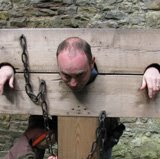My dad and uncle recently discovered a letter from Primrose, apparently written on VE Day (but dated May 9th), which made that experience incredibly real for me, from the fears, loss and privations of war to the yearning for word from a family across the sea to the relief and hope for the future. Read it below.
Eskeleth
Voorschoten
9th May 1945
Darling Mummy
On VE day we are sitting in the garden in glorious weather, with our two sturdy infants toddling around the lawn. And the thoughts I have above everything else in these thrilling,marvellous days are: 'How are they at home? How are they doing? When shall I hear from them? ', etc. We are all well and quite healthy in spite of the strain of the last five years and the terrors and unspeakable famine of the last six months. Oh, what a glorious thing freedom is! It seems the most important thing in our lives now and a thing I shall treasure the rest of my life. How I have longed for news from you, especially since I had your last message some time round about March last year.
Timothy is wandering about picking buttercups and daisies – he is a picture with his rosy cheeks and very blond curls. Clare is waving to a British bomber overhead, bringing the desperately needed food to an airfield nearby. Both children speak English and some Dutch. Clare longs to go to “G'anny” and “Eng'and”, not to mention how her mother longs. We expect to be allowed to leave in about two months' time. Meanwhile, we hope to return to a more or less normal life and to enjoy the food sent from England. You have no idea what life has been like these years and this winter has been ghastly. The V2 rockets were fired off from Wassenaar and The Hague, an you can imagine the ravages done as 50% exploded here, and the Allies bombed the district (very heavily at times) all day long. We have been out of our house twice. Last May the SS turned us out and occupied the place for months. We returned just before Christmas and Bernard had to hide for months, like all men under 40. Everyone had to have secret hiding places in their houses and to have a wireless was a very risky thing – meant concentration camp or death. However, we kept ours and listened every day [to the BBC] under the stairs. I shall have a lot to tell on my return home. And what a lot I want to know about you all. To be separated from you all under these dreadful circumstances has been very hard to bear. My visit home will be a long one, probably lasting three months or so. I feel very tired, having had no holiday since 1939 and very little help indeed. With two tiny children it is at times too much for me. How marvellous that the summer is here – people had no coal or food last winter, no electricity or gas – can you imagine the chaos? A large part of our daily diet has been sugar-beets (horrible) and tulip bulbs. We were glad to have them. It has been a blessing to live in the country.
I shall write more news next time but don't want to make this too long. I have an English friend and her husband and child living here. Their house was destroyed in the bombardment of 3rd March last, when a huge part of The Hague was burnt down, including our English church, which had been closed since 1940. This morning we went to a service in the village for the peace thanksgiving. The British troops are arriving all the time and I hope to meet some soon and bring them home. We long to speak to a soldier from England. Yesterday saw still a few Germans about looking very miserable. Vile creatures, how they are loathed here. Lots and lots of love to you all, darlings, and I long for a word from you.
Your loving Primrose.
PS Love from Bernard, Clare and Timothy. Daisies from the children.
